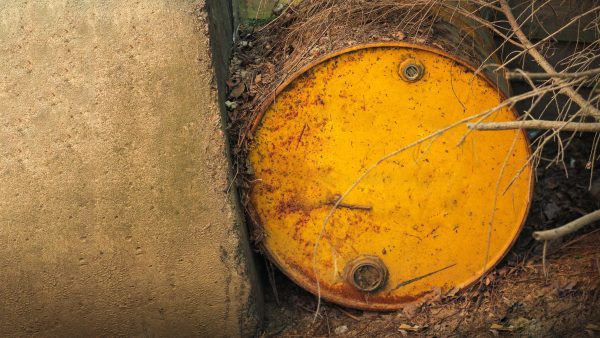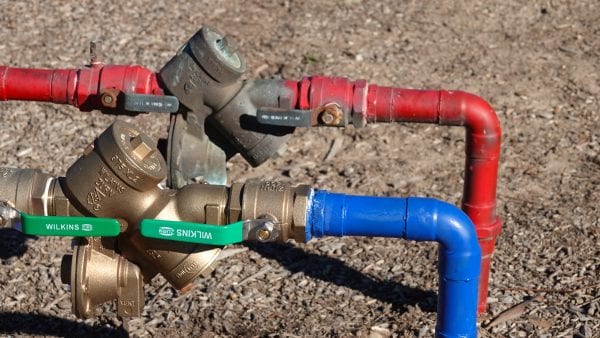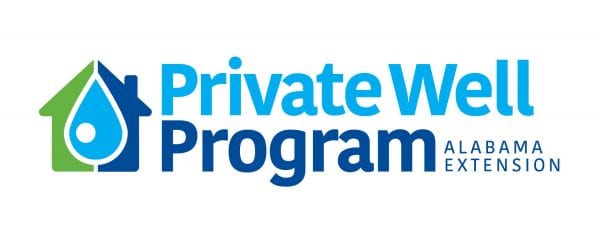Fish & Water

A well is not guaranteed to have consistent water quality over time. For those that rely on groundwater for drinking, protecting the well and wellhead is important to the health of their household and neighbors. Contaminants can enter groundwater from surface contamination seeping into the water table or directly into a well itself. Groundwater is not always confined to one area, so if contaminants enter a well, that groundwater contamination can spread to other areas and impact drinking water quality. Hundreds of wells often tap into the same aquifer. Taking steps to protect the wellhead is often an easier and less expensive way to ensure the quality of the water supply.
Components of Well Protection
Selective Well Location
Proper well protection starts with the placement of the well. Wells should be located high in the landscape so that surface water drains away from it and pesticides or other contaminants are not flowing towards the well. The well should not be located in a flood-prone location unless the casing extends at least 2 feet above the level of the highest known flood on record. To read more about well siting, visit Water Well Placement – Why Does it Matter?.
Proper Well Construction
It is a good idea to look into the current construction standards for wells in Alabama. Some things that were the norm even 30 years ago are now considered dangerous, unsafe, or a threat to groundwater. While a well may currently be working, its method of construction may pose groundwater contamination threats, impacting the drinking water.
Properly Storing Chemical Contaminants
Many wells also have a well house. All too often people treat the well house as a garden shed. Chemicals should never be stored in a well house. If they leak or spill, they can seep into the ground and into groundwater.
 Never dispose of household chemicals, motor oil, or personal care products by pouring them onto the ground, flushing them down the drain, or down the toilet. Never flush excess medication down the toilet, especially if on a septic system. Many of these chemicals are not filtered out, even in public drinking water supplies. Take excess medication to a collection facility if possible. Generally, pesticides, solvents, or petroleum products are not naturally occurring contaminants in groundwater, but improper human use of chemicals can result in well water contamination.
Never dispose of household chemicals, motor oil, or personal care products by pouring them onto the ground, flushing them down the drain, or down the toilet. Never flush excess medication down the toilet, especially if on a septic system. Many of these chemicals are not filtered out, even in public drinking water supplies. Take excess medication to a collection facility if possible. Generally, pesticides, solvents, or petroleum products are not naturally occurring contaminants in groundwater, but improper human use of chemicals can result in well water contamination.
Some examples of activities that can potentially pollute groundwater may be the following:
- storing, mixing, or spraying chemicals or pesticides too close to a well or other water supply
- pouring gasoline on fire ant mounds
- accidental chemical spill
- improper disposal of chemicals down storm drains, household drains, or down the toilet
- improper disposal of chemicals from old manufacturing sites
- petroleum leaks or spills
The Clean Day Pesticide Collection Program is a free service offered to Alabama residents and is a joint effort between the Alabama Department of Agriculture and Industries and the Alabama Cooperative Extension System. This program allows participants to bring unwanted household hazardous wastes for safe and environmentally sound disposal. Products that will be accepted for disposal include pesticides, herbicides, fungicides, and rodenticides. Products that have lost registration, illegible labels, or are out of date are also accepted. Contact your county Extension office to inquire about upcoming clean-up days.
There are certain factors that could contaminate the groundwater with organic chemicals:
- Proximity to the contamination source. Wells located near industrial or commercial areas, gas stations, landfills, railroad tracks, or farm fields often get contaminated with organic chemicals
- Well depth. Shallow wells are generally more easily affected than deep wells from spills or surface-applied organic chemicals.
- Geology of the area. Aquifers under thin, porous soil or sand layers are more vulnerable than ones under dense, thickly layered clay soils which acts as a barrier.
- Improper well construction and inadequate wellhead protection status. Improperly constructed wells along with inadequate wellhead protection measures make wells especially vulnerable to contamination because of the potential for surface run-off and hazardous waste spills to make their way into the water supply.
Preventing Backflow
 If water pumped from the well into your home accidentally flows back into the well, it can contaminate the water system. Preventing backflow is critical to protecting the water system. If a pump stops working while a hose is submerged in chemicals, the backflow because of a drop in pressure could draw those chemicals back into the well. Water from laundry, swimming pools, tubs, or sinks can also back flow through plumbing. Install a double check valve backflow preventer between a well and an irrigation system.
If water pumped from the well into your home accidentally flows back into the well, it can contaminate the water system. Preventing backflow is critical to protecting the water system. If a pump stops working while a hose is submerged in chemicals, the backflow because of a drop in pressure could draw those chemicals back into the well. Water from laundry, swimming pools, tubs, or sinks can also back flow through plumbing. Install a double check valve backflow preventer between a well and an irrigation system.
Testing Well Water
It is the responsibility of the well owner to test their own private water supply. People should test their water once a year, particularly for bacteria and nitrates. Testing for other contaminants should be done every few years, if there is a reason to suspect their presence, or if there is a change in the taste or smell of the water. The National Ground Water Association (NGWA) recommends well owners test their water at least annually for bacteria, nitrates, and any contaminants of local concern. More frequent testing should be considered if
- there is a change in the taste, odor, or appearance of the well water, or if a problem occurs such as a broken well cap, inundation by floodwaters, or a new contamination source.
- the well has a history of bacterial contamination.
- the septic system has recently malfunctioned.
- family members or house guests have recurrent incidents of gastrointestinal illness.
- an infant is living in the home.
- the owners wishes to monitor the efficiency and performance of home water treatment equipment.
When testing the water regularly, people develop a long-term vision of whether or not the water quality is changing over time. Having this information can help people pinpoint any potential sources of contamination. Visit Where to Get Your Well Water Tested to find testing labs near you. Be sure to maintain a regular testing schedule for the well and keep test results on file for future reference and comparison.
Performing Routine Maintenance
Repairs to private water systems are expensive. By implementing routine maintenance and inspection of the water well, you can ensure the proper operation of the well and minimize concerns of adverse health impacts associated with compromised water systems.
Conducting Visual Inspections of the System
Visual inspections can help to assess some immediate well concerns. During this evaluation, take the time to ensure that the well casing extends at least 12 inches from the ground, the well cap is securely attached and free of debris, and that the electrical connections are secure. This visual inspection is also a great time to examine the area surrounding the well. A properly sealed well cap should help reduce the flow of contaminants into the well. Do not store chemicals, paint, fertilizers, feeding areas, waste systems, and pesticides around the wellhead.
More Information
For more resources for private well owners, visit the Private Well Program webpage at www.aces.edu.


